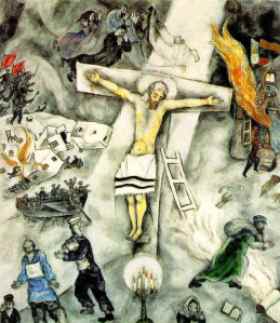By Kayla Green
 For the first time in history, Marc Chagall’s Bible-themed engravings, originally intended as a gift for his second wife, are on display to the public. The engravings are part of the “Chagall and the Bible” exhibit in Paris’s Museum of Jewish Art and History which contains 105 of Chagall’s engravings illustrating the 1956 edition of the Bible. The full exhibit consists of half of Chagall’s preliminary sketches for the book’s engravings, 25 oil paintings of Biblical scenes and watercolor and gouache mock-ups of Chagall’s glass work. These intimate and historically rich pieces lend insight into the deep complexity of Chagall’s Jewish legacy, from his identity as a Jew in exile to his reawakening upon his first visit to Israel. Most importantly, they are able to convey Chagall’s interesting perspective of what it means to be a Jew in a Christian world, as well as the Jewish aspects of Christian life.
For the first time in history, Marc Chagall’s Bible-themed engravings, originally intended as a gift for his second wife, are on display to the public. The engravings are part of the “Chagall and the Bible” exhibit in Paris’s Museum of Jewish Art and History which contains 105 of Chagall’s engravings illustrating the 1956 edition of the Bible. The full exhibit consists of half of Chagall’s preliminary sketches for the book’s engravings, 25 oil paintings of Biblical scenes and watercolor and gouache mock-ups of Chagall’s glass work. These intimate and historically rich pieces lend insight into the deep complexity of Chagall’s Jewish legacy, from his identity as a Jew in exile to his reawakening upon his first visit to Israel. Most importantly, they are able to convey Chagall’s interesting perspective of what it means to be a Jew in a Christian world, as well as the Jewish aspects of Christian life.
The three-story exhibition is filled with bright colors and dramatic artistic touches. The whimsical Biblical scenes are accompanied by multi-lingual Biblical verses, ensuring comprehension for each viewer, while the gouache mock-ups of stained glass windows are eye-catching with their vivid orange and purple hues. More amazing than the splendor and beauty of Chagall’s work is the symbolism and meaning that underlies it.
Chagall’s art attempts to reconcile Jews and Christians, usually by depicting Christian beliefs and history through a Jewish lens, creating the effect that Jews and Jewish history are integral to Christian survival and legacy. In one painting, entitled White Crucifixion, Jews flee their Nazi persecutors while Jesus hangs above them on the cross, trying to protect them. This heartbreaking image exposes Chagall’s perception that gentile society could only understand the plight of the Jews in Christian terms. In fact, Chagall painted more than 100 scenes of Jesus and the crucifixion in his life. The connection between Judaism and the New Testament was a common theme in Chagall’s art, says Susan Goodman, senior curator of New York’s Jewish Museum. “It was a way of asserting an ideological challenge to the dominant Christian culture. He was asserting the Jewishness of Christ.” Here, moreover, we can see Chagall trying to downplay the “otherness” of the Jews by reasserting the original connection between Christ and Judaism.
Chagall’s worldview represents the difficulties he faced as a Jew, from his exile from Russia to France and his eventual move to the United States during the time of World War II. The inspiration he found in his trip to Israel, where he visited Jerusalem and the Western Wall is also palpable from the exhibit. What it best describes though, is the complexity of Jewish-Gentile relations. In the middle of Paris, a city known for both philo-Semitism, and xenophobia, art-lovers are introduced to one man’s attempt to explain the plight of the Jews by emerging them in familiar Christian settings as well as his ability to demonstrate the Jewish roots of Christianity. The overall effect is both unifying and eye-opening, as it conveys that peace and understanding art can convey.

2 thoughts on “Chagall's Crucifixions”
Thank you for this informative view of Chagall. His work has always been mystical with a historic feel but reading your blog has made me rethink how he approached his life. His relationship to his faith and with those of his Christian neighbors is an interesting way to view his art.
I walk past and glance at the Chagall glass windows at the Metropolitan Opera House at Lincoln Center, New York daily. Although they are not the ones you depict, I will now think of his art and life in a different way. Thank you for your choice in subject, and for giving your reader another way to approach Chagall’s work.